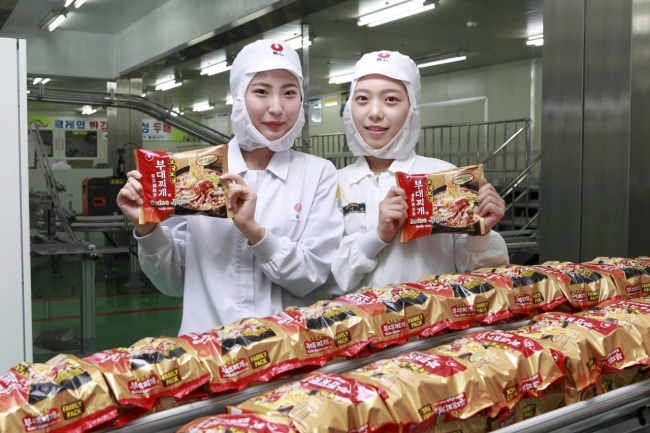Exports of Korean instant noodles are poised to hit $300 million this year, with strong growth in unique premium products.
According to the Korea Customs Service on Monday, exports of Korean ramen so far in 2016 have totaled $232.7 million, up from yearly totals of $218.8 million in 2015 and $208.5 million in 2014. This was the first year that exports had broken $200 million by the end of the third quarter.
Leading ramen producer Nongshim is riding on the surge in exports. It announced Monday that it has shipped 27,000 boxes of its Budae Jjigae Ramyeon to the US, just four months after the product was released here.
 |
Models pose with budaejjigae-ramyeon from Nongshim to be exported to the US. (Nongshim) |
Budae Jjigae Ramyeon, modeled after the Korean stew made with kimchi, ham and sausage, is the latest product from Nongshim to be shipped abroad. The company has previously seen massive success with its flagship Shin Ramyeon and significant sales with its recent Chinese-style noodles Jjawang and Matjjamppong.
Nongshim, which exports to 100 countries, said its overseas sales make up 25 percent of overall revenue. Nearly 40 percent of overseas sales come from China.
“Consumers abroad respond to our products because they don’t try to emulate local flavors, but stay true to the original Korean style of ramen,” said a spokesman for Nongshim.
Export sales are an important source of growth for the ramen industry, which is fighting an intense battle for market share here.
Analysts such as Kim Tae-hyeon at LIG’s Research Division have said in reports that in the “domestic market where it is difficult to increase sales volume, it is becoming increasingly necessary to increase profits through raising prices.”
Competition has been especially fierce in the premium ramen category, which brings together the low cost and convenience of instant ramen with healthier ingredients and traditional cuisine.
In response, ramen companies are turning to the overseas market, with Ottogi and Paldo increasing ramen exports by 20 percent and 10 percent, respectively, in the first half of 2016.
Nongshim kicked off the premium instant noodle trend last year with Jjawang, which combined ramen with the Chinese-style black bean noodles known here as jjajangmyeon. However, it was soon met with competition from rival Ottogi, which came out with Jin Jjamppong, inspired by the Chinese spicy seafood noodle dish.
This year, the trend in ramen has shifted away from Chinese-inspired variations to budaejjigae-style ramen, as companies quickly churn out new products in the hopes of gaining ground.
Ottogi came out with its own Budaejjigae Ramyeon just 12 days after Nongshim’s launch. Distributors such as convenience store chains GS25 and CU have thrown their hats into the ring with their own launch of kimchijjigae-inspired ramen varieties as well.
By Won Ho-jung (
hjwon@heraldcorp.com)








![[Today’s K-pop] Blackpink’s Jennie, Lisa invited to Coachella as solo acts](http://res.heraldm.com/phpwas/restmb_idxmake.php?idx=644&simg=/content/image/2024/11/21/20241121050099_0.jpg)